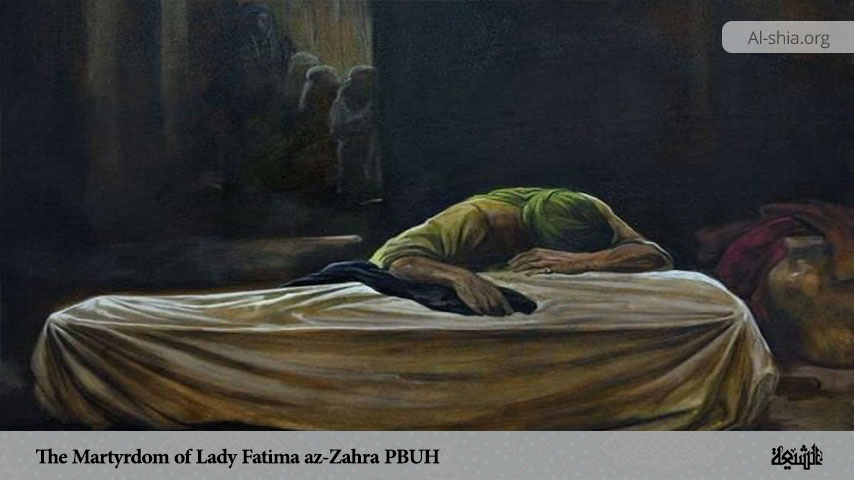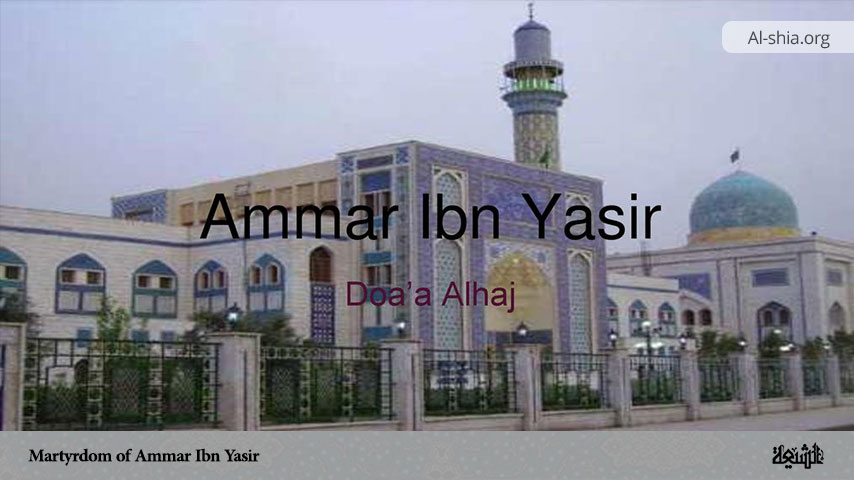Lady Fatima Az-Zahra (peace be upon her) is the beloved daughter and the only surviving child of the Messenger of Allah (peace be upon him and his household). She was also the first person among the members of the Prophet’s pure Household (Ahl al-Bayt) to reunite with him. Lady Fatima is the perfect role model of a woman to the entire women of the Universe. She left a purposeful life as a daughter, a wife, and a mother.
Martyrdom of Lady Fatima (PBUH) refers to the death of Fatima, the beloved daughter of the Prophet of Islam (PBUHH) as a result of injuries she suffered at the hands of some of the companions of the Prophet. The issue of the martyrdom or natural death of Lady Fatima (PBUH) is one of the disputed issues between Shiites and Sunnis[1]. The Shiites, despite some differences in the narration of the events after the demise of the Prophet (PBUHH), commonly believe that Lady Fatima (PBUH) was martyred and this event was due to an injury inflicted on her and the abortion of her unborn child. On the other hand, the Sunnis believe that she died a natural death due to illness and grief over the demise of the Prophet[2] (PBUHH). In view of this, the present paper aims to examine the martyrdom of Lady Fatima the circumstances surrounding her martyrdom, and the legacy she left behind.
Prophetic Conversation
It is documented in the historical reports that during the tenth year of Hijrah when the Prophet (PBUHH) returned to Medina from the farewell pilgrimage to Mecca. He invited his daughter and the following conversation happened:
Oh my daughter! Gabriel used to reveal the Qur’an to me once a year but he revealed it to me twice this year.
Oh dear father! What does that mean?
I think this year is the last year of my life. Lady Zahra got disturbed and depressed. Tears were dropping from her eyes and her father concluded his speech with this sentence: Oh my daughter! You will be the first person from my family to join your father!
And a smile was noticed on Zahra’s lips. The audience asked the reason for the tears and then the smiles simultaneously, but Lady Zahra (PBUH) answered shortly after that day[3].
Circumstances Surrounding Her Martyrdom
After the death of the Messenger of Allah, the members of his Household, including Lady Fatima witnessed a series of attacks from the Muslim community. Despite the clear indications given by the Prophet regarding the succession of Imam Ali (PBUH) at Ghadir Khumm[4], a faction within the Muslim community moved swiftly to appoint a new leader through the Saqifah assembly[5]. This decision was made without consulting the immediate family of the Prophet, particularly Imam Ali (PBUH), who was busy with the funeral rites of the Prophet. The controversial appointment of the first caliph and the political maneuvering that ensued created significant tension between the supporters of Imam Ali (PBUH) and the newly established leadership. Lady Fatima (PBUH), as the daughter of the Prophet and the wife of Imam Ali, became a central figure in this conflict due to her unwavering support for her husband’s rightful claim to leadership.
One of the most tragic and widely documented events leading to her martyrdom was the attack on her home. According to numerous historical sources, in an attempt to secure allegiance from Imam Ali (PBUH), a group of men, acting on orders from the authorities, came to the door of Lady Fatima’s house. When Imam Ali (PBUH) refused to give his pledge, the aggressors threatened to burn down the house, knowing that Lady Fatima (PBUH) and her young children were inside.
Come out! Come out! Otherwise, we will burn you all! Umar Said. The Prophet’s daughter came out and met Umar who was holding fire in his hand. O Umar! What happened? What’s going on here? Lady Fatimah inquired. Ali, Abbas, and Banu Hashim must come to the mosque and swear allegiance to the Caliph of the Prophet! Which Caliph? The designated leader of the Muslims is sitting by the holy body of the Prophet inside Aisha’s house. From this moment, the [selected] leader of the Muslims is Abu Bakr, Umar replied. The people had pledged allegiance to him in Saqifah of Bani Sā’idah. Thus, Banu Hashim must also swear allegiance to him. And if they don’t come for the oath of allegiance, I will set the house together with whoever is in it on fire unless you also accept what the Muslims have accepted. O Umar! Do you want to set our house on fire? Of course[6].
What followed was a violent intrusion that resulted in severe harm to Lady Fatima (PBUH). According to reports, the door was forcibly pushed against her, causing injuries that led to the miscarriage of her unborn son[7]. The physical trauma, combined with the emotional distress of witnessing her family’s rights being violated, significantly weakened her health.
A few days after the incident, another incident happened. The land of Fadak which had been given to Lady Fatima by the Prophet during his lifetime was snatched away from her and her husband was roughly handled by the Caliph. Lady Fatima (PBUH) publicly contested this decision, arguing her case based on both Qur’anic principles and the Prophet’s explicit gift to her[8]. The loss of Fadak was not just a matter of property; it was symbolic of the broader struggle for justice and the preservation of the Prophet’s legacy. Her famous sermon in the mosque of Medina, where she eloquently defended her rights, stands as a testament to her courage and steadfastness in the face of political oppression. However, her protestations were met with resistance, further escalating tensions between her family and the ruling powers.
Her Reunion with her father
Truly, the death of her most beloved father, the oppression of her husband, the loss of her rights, and above all, the changes that appeared within a very short period in the Muslim culture after the Messenger of Allah deeply hurt the soul as well as the body of Lady Fatima.
During the last days of her life, Lady Fatimah asked for Asma, the daughter of Umais, who was one of the emigrant women and one of his relatives, and said to her: I don’t like putting on a garment over a woman’s corpse but her body is still visible from under the garment. I saw something in Abyssinia, I will show its pattern to you now. Then she asked for some wet branches. He bent the branches. She put on a cloth over it.
The Prophet’s daughter said: What a good thing. It distinguishes a female corpse from that of a male. When I died, you wash me and do not allow anyone to come near my corpse[9].
In the last days of her life, she requested water. She washed her body well, put on new clothes, and went to her room. She told her maid to spread her bed in the middle of the pavilion and then she laid down facing the Qiblah, put her hands on her cheeks, and said, “I will die this very hour”[10].
According to Shia scholars, her husband Ali (PBUH) washed her. And it seems that Asma had assisted him in the ritual washing of Lady Fatimah (PBUH). Ibn Abd al-Barr documented that at the moment Lady Fatimah left this world, Aisha wanted to enter her room, but Asma did not allow her based on her will. Aisha complained to her father thus: “This Khath’ami woman came between me and the Prophet’s daughter, and she won’t let me go near her corpse. In addition, she made a curtain for her, like the bride’s chamber”.
Her Burial Place
According to several narrations, Lady Fatima -based on the last will to her husband- was buried at night[11]. This nightly burial was done as she did not want those who had wronged her to attend her funeral and burial[12]. Therefore, the place of Lady Fatima’s burial place is unknown. The Shia scholars brought narrations that show that the Prophet’s daughter was buried in the Baqi cemetery. In addition, from these narrations, it is said that seven other graves were made to hide the actual grave of the Prophet’s daughter, and according to other narrations, forty other graves were made. On the morning of that day, they wanted to take out the corpse of the Prophet’s daughter from the grave and perform the burial prayer over it, but because they faced Ali’s strict opposition and severe restrictions, they desisted from this act. Anyhow, the hiding of the grave of the Prophet’s daughter portrays her displeasure with some people and it is clear that she wanted to reveal her displeasure through this act.
Her Legacy
The legacy of Lady Fatima Az-Zahra (PBUH) is one of profound spiritual, social, and political significance that continues to inspire Muslims around the world. As the beloved daughter of the Prophet Muhammad (PBUHH), her life exemplified unwavering faith, deep devotion, and steadfast resistance against injustice. Despite facing immense hardship, particularly after the Prophet’s death, she stood as a beacon of truth, courageously defending the rights of her family and the principles of Islam. Her eloquent speeches, such as the Fadak Sermon, remain powerful calls for justice and serve as timeless lessons in standing against oppression. Her martyrdom, a result of her refusal to accept the unjust political changes after the Prophet’s passing, made her a symbol of sacrifice and resistance, particularly among Shia Muslims. Her choice to be buried in an unmarked grave was a final act of protest, symbolizing the betrayal she endured. Today, Lady Fatima (PBUH) is remembered not only as the “Leader of the Women of Paradise” but also as a paragon of moral integrity, strength, and enduring resilience, whose life and legacy continue to guide the faithful toward the pursuit of justice and piety. She is indeed a perfect role model of a woman to the entire women of the Universe.
Conclusion
The martyrdom of Lady Fatima Az-Zahra (PBUH) stands as a deeply significant and tragic event in Islamic history, symbolizing the profound struggle for justice and the rightful leadership of the Muslim ummah. Her life, marked by an unparalleled devotion to her father, the Prophet Muhammad (PBUHH), and her steadfast support of Imam Ali (PBUH), exemplifies the values of integrity, sacrifice, and resistance against oppression. The events leading to her martyrdom highlight the intense political and social turmoil that emerged in the wake of the Prophet’s passing, leaving a legacy of division that continues to shape Islamic thought today. Her eloquent defense of her rights, her courage in the face of injustice, and her ultimate sacrifice remain powerful reminders of the enduring principles of faith, resilience, and the pursuit of truth. As both a spiritual and moral exemplar, Lady Fatima’s (PBUH) legacy continues to inspire Muslims to uphold justice, advocate for the oppressed, and remain unwavering in their commitment to the teachings of Islam.
References
[1] . Mahdī, Abd al-Zahrāʾ, Al-Hujūm ʿalā bayt Fāṭima (a), p. 14.
[2] . Mudayhish, Fāṭima bint al-Nabī, vol. 3, p. 431-550.
[3] . Ibn Sa’ad, Ṭabaqāt, vol. 8, p. 17; Kashf al-Ghummah, p. 15.
[4] . Al-Amini, Al-Ghadir, Vol.1, p. 14 afterwards.
[5] . Ibn Qutayba, al-Dīnawarī, ʿAbd Allāh ibn Muslim, al-Imāma wa al-Sīyāsaʾ, vol. 2, p. 22.
[6] . ‘Aqd al-Farīd, p. 2; Ansāb al-Ashrāf, p. 586.
[7] . Shahristānī, Muḥammad ibn ʿAbd al-Karīm, al-Milal wa al-Niḥal, vol. 1, p. 71.
[8] . Shahīdī, Sayyid Jaʿfar, Zindigānī-yi Fātimā-yi Zahrā, p. 121-122.
[9] . Istī’āb, p. 751; Ibn Sa’ad, Ṭabaqāt, vol. 8, p. 18; Ansāb al-Ashrāb, p. 402, Majlisi, Bihār al-Anwār, vol. 43, p. 189.
[10] . Bihār al-Anwār, vol. 43, p. 172 Ansāb al-Ashrāb, p. 402; Ṭabaqāt Ibn Sa’ad, vol. 8, p. 17-18.
[11] . Yūsufī Gharawī, Muḥammad Hādī, Mawsūʿat al-Tārīkh al-Islāmī., vol. 4, pp. 157-162.
[12] . Fattāl al-Nayshābūrī, Muḥammad ibn al-Aḥmad, al-Rawḍat al-wāʿiẓīn wa baṣīrat al-muttaʿizīn, vol. 1, p. 151.


















